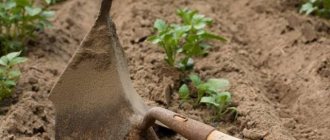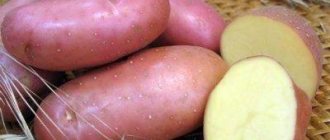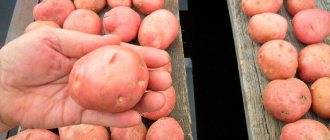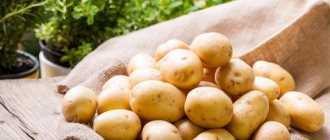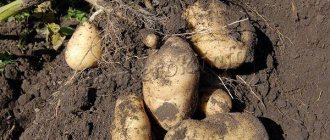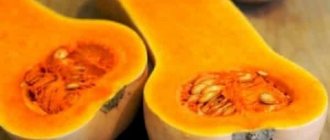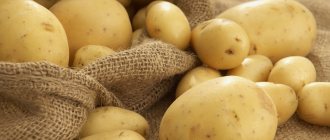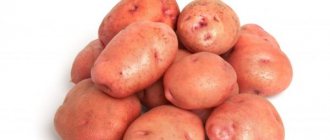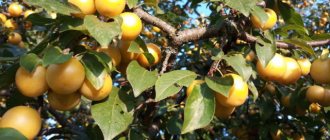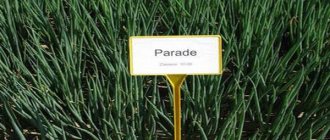Adretta potatoes are quite in demand among gardening lovers. It is chosen for its high degree of productivity and excellent taste. The creators of this famous variety were German breeders from the company Norika Nordring-Kartoffelzucht und Vermehrungs GmbH (Germany). In 1980, Adretta was included in the State Registers of Belarus and the Russian Federation. To successfully grow this varietal potato, you need to know what its strengths and weaknesses are, what the algorithm for planting and further care is.
Description and distinctive features of the variety
The Adretta variety was bred by breeders from Germany and presented to a wide range of consumers about 20 years ago. Previously, varieties with a yellowish tint to the pulp were most often classified as fodder. However, with the advent of Adretta, everything changed, the variety made a real splash on the domestic market, and the yellow tubers were no longer considered fodder.
Adretta is highly valued due to its excellent taste, as well as its light crumbliness when cooked due to the high starch content, which gives special softness and tenderness to the finished dish.
The bushes of the plant are erect, of medium height, with large and frequent leaves of light green color. Flowering is abundant. The inflorescences are white, spreading.
The Adretta potato bush is an upright plant with large, light green leaves, prone to abundant flowering.
Adretta tubers are large in size. The weight of one potato is 140–150 g. The shape of the tubers is oval, the skin is dense and dry. The pulp is light yellow in color, which becomes even more saturated when cooked.
The skin of the tubers, like the pulp, is a pleasant light yellow color.
The variety is famous for its unpretentiousness to the soil, like some of its other brothers. And when tubers are frozen, you don’t have to worry about a change in taste and the appearance of the notorious sweetness.
The Adretta potato variety contains a large amount of vitamin B6, which is involved in the production of glycogen for muscle function, as well as carbohydrates, which help maintain the body in good shape during physical activity. The starch content in potato tubers is 16–17%, and the protein content is 2.2%.
Table: advantages and disadvantages of the variety
| pros | Minuses |
| High yield | Susceptibility to late blight, common scab and macrosporiosis. |
| Resistance to many viral diseases | |
| Good keeping quality | |
| Transportability at low temperatures | |
| Frostbitten Adretta tubers, unlike other varieties, do not become sweet | |
| The percentage of spoilage and rotting during storage is minimal |
Video: main characteristics of Adretta potatoes
General characteristics of the variety
Adretta was bred about twenty years ago and is a table potato variety. It is very popular because it has good taste, which is widely used for preparing various dishes. Adretta has a crumbly structure after boiling due to its starch content - 16%.
The bush itself is an upright plant with deep green leaves. The flowers have white corollas. The tuber is oval in shape, the pulp is yellow, the peel is the same color with a small number of small sprouts. On average, a potato of this variety weighs about 130 grams.
Adretta gives high yield (40-45 tons per 1 ha). About 25 tubers can form on one bush. Their ripening period lasts from 70 to 105 days, depending on care and weather conditions.
The popularity among gardening enthusiasts also lies in the easy care of the above variety, since it is resistant to most viruses, pests and tolerates various weather conditions.
Landing Features
Despite the fact that the Adretta potato variety is characterized as unpretentious and tolerates temperature changes well, you should follow some planting rules in order to get a good harvest in the future.
Seed material
To plant Adretta, take seed tubers, which need to be germinated in advance. It is enough to scatter them in a dry room on the floor, and within a few weeks green sprouts will appear on them. After this, lightly spray the potatoes with water and cover them with plastic wrap. This will ensure faster root germination.
The process should begin in early April, since in May it is time to start planting tubers in the soil.
Selecting a location
Light and well-drained loamy and sandy loam soils, which ensure the best supply of moisture and air to the roots and tubers of the plant, are ideal for planting Adretta potatoes. In addition, sandy loam soil promotes the accumulation of a higher percentage of starch. It is also worth considering that potatoes prefer open, well-lit areas.
Preparing for landing
On peat soils, it is necessary to add 200–300 kg of sand per 1 sq.m., and heavy loams are lightened by adding humus at the rate of 500 kg per 1 sq.m. Before planting, the tubers are cut into pieces so that each has 1-2 eyes. This division will ensure a bountiful harvest.
After cutting, the cut area should be well powdered with wood ash.
Landing technology
When planting potatoes, dig small holes 8–10 cm deep at a distance of 35–40 cm from each other and 50–60 cm between rows.
It is believed that a clove of garlic, which should be lowered into the hole along with the tuber, will be an excellent repeller against mole crickets.
To ensure simultaneous germination, the planting depth of the tubers must be the same
Before placing planting material in the hole, you should add 1 tablespoon of cow humus and urea into it, and place the tuber on top with the sprout facing up.
After planting, the ground must be leveled with a rake to prevent premature evaporation of moisture.
Pest Control
Unfortunately, this variety is loved by various beetles and parasites. Therefore, if you plant planting material in places where various pests accumulate, then you will have to work hard to get them out.
Among the common connoisseurs of Adretta are:
- Wireworms. Yellow worms that reach 20 centimeters in length. They chew potatoes and make tunnels in them. To avoid encountering these parasites, you need to plant the fruit in the place where legumes previously grew. Also, before planting, you need to get rid of weeds and fertilize the acidic soil with lime.
- Colorado beetles. America has pleased us with its pets, with whom it is no longer boring in the garden. We won’t tell you how to deal with them. There are a lot of spray products available. Well, or, as a last resort, assemble it by hand.
- Nematodes. One of the main potato pests. Males resemble worms, and females resemble balls. To prevent these parasites from settling on the fruit, it is necessary to water the potatoes with chicken droppings immediately after planting. Also, an effective method is to treat the soil with special agents against nematodes. This is done 14-20 days before planting the planting material.
- Medvedka. It is because of this that it is not recommended to plant potatoes where tomatoes previously grew. As in the case of the Colorado potato beetle, the fight against the mole cricket comes down to the use of special chemicals. As practice shows, it is almost impossible to prevent the appearance of this parasite.
Plant care
To significantly increase yield, as well as prevent spoilage of tubers, potatoes should be looked after. Proper weeding, watering, hilling and timely control of pests and diseases will ensure active and healthy growth of the plant.
Hilling
Hilling up potatoes is a mandatory procedure in growing technology. It is necessary to retain moisture, form new roots and tubers, and saturate the soil with oxygen.
Plants should be hilled twice per season. The first hilling is done when the sprouts are 8–10 cm above the ground, the second time when the height of the bush is 20 cm.
Important! Before hilling, the soil should be moistened.
Hilling accelerates the processes of bush development, flowering and tuberization, and also protects potato tubers from late blight
The hilling procedure is carried out in the morning or evening hours, since the midday sun can have a detrimental effect on the plants. In hot and dry climates, when it is not possible to provide regular watering, you should refrain from hilling. In loose, dry soil, the tubers can bake. In this case, it is enough to loosen the soil between the rows, removing weeds and breaking up dry lumps to ensure air exchange and good growth.
Video: hilling potatoes
Watering
Like other varieties, Adretta potatoes do not tolerate drought and excessive stagnation of water. Keep the soil moist and water the potatoes as needed. One bush requires 3–4 liters of water. Watering can be done by sprinkling and in specially formed furrows.
Important! A day after watering, the soil must be loosened properly using a hand hoe.
Loosening must be done very carefully, trying not to damage the sprouts and not pull the tubers to the surface
Top dressing
It is best to apply fertilizer in the morning or evening in dry, calm and windless weather.
- If the shoots grow weak and thin, and the leaves look unhealthy, it is necessary to apply the first portion of fertilizer. Dilute 1 tablespoon of urea or ammonium nitrate into 10 liters of water. A solution of fresh mullein or bird droppings in a proportion of 0.5 liters per 10 liters of water is also suitable. 500 g of fertilizer is applied to each bush.
- When buds form on the tops, it is advisable to carry out a second feeding to speed up flowering. 3 tablespoons of ash and 1 tablespoon of potassium sulfate are dissolved in 10 liters of water. Half a liter of fertilizer should be applied to each bush.
- The third feeding is carried out during the flowering period to accelerate and increase the growth of tubers. To obtain the necessary mixture, you should dilute 1 glass of fresh mullein or bird droppings in a bucket of water, and then add 2 tablespoons of superphosphate to the resulting solution. Fertilizer is applied 0.5 liters for each bush.
Diseases and pests
To preserve the integrity of the crop, care should be taken to protect against potentially dangerous pests and diseases. And although the Adretta potato variety is resistant to viral diseases, it is necessary to carry out preventive procedures that will save the plant from possible troubles.
Table: prevention and methods of controlling diseases and pests
| Disease/pest | Nature of the lesion | Processing period | Fighting methods | Prevention measures |
| Late blight | Dark brown spots appear on the leaves and stems of the tops, which leads to their rotting and drying out. Gray rot appears on the tubers. | When the first signs are identified. From 2 to 4 times every 10 days. | Spraying with Kuproksat fungicide (3 l/1 ha) or copper oxychloride solution (40 g/1 bucket of water). |
|
| Macrosporiasis | Dry brown spots and superficial cankers form on leaves, stems and tubers. | When the first signs are identified. From 2 to 4 treatments every 7–10 days. | Treatment with Kuproxat, copper oxychloride, Bordeaux mixture or Abiga-Pik (50 g/10 l of water). |
|
| Common scab | Dry and wet rot appears on tubers with excessive soil moisture. | Before landing. | Adding 40 g of ammonium sulfate per 1 sq. m or Calimagnesia with superphosphate, 30 g per 1 sq. m to maintain the acidified state of the soil. |
|
| Aphid | It affects leaves and young shoots of potato tops, which leads to their rotting and drying out. | During the growing season. | Spraying:
|
|
| Colorado beetle | Eats leaves of potato tops, apical buds, stems. Often the entire bush dies. | When larvae appear. Treatment 3-4 times every 7 days. | Spraying with Bitoxibacillin solution (50–100 g/10 l of water) + 2 tbsp. spoons of milk powder for better adhesion of the solution. | Regular inspection and manual collection of clutches of eggs, larvae, beetles and their destruction in a concentrated saline solution. |
| Greenhouse whitefly | It attacks leaves, sucking out all the nutrients from them. | During the growing season. | Spraying with Phosbecid (40 ml/10 l of water). Spray 2 liters per 10 square meters. m. | Planting next to tomatoes is not recommended. |
Photo gallery: main diseases and pests of potatoes
Late blight is the most harmful potato disease. Productivity decreases by 70% or more
Under favorable conditions, aphids reproduce very quickly. In a week, its number can increase 5 times
The source of common scab infection is contaminated soil. The pathogen can also persist on planting material
By sucking cell sap, the greenhouse whitefly causes yellowing of the leaves.
Macrosporiosis mainly affects leaves and manifests itself in the form of dry dark brown round or angular spots with clearly defined concentric zones
Colorado beetles and their larvae feed little, but their damage is easily noticeable, since mainly young leaves are affected
Advantages and disadvantages
Among the positive characteristics of the German variety, experienced summer residents highlight:
- high yield rates;
- excellent taste;
- good shelf life (95-98%);
- transportability;
- fast ripening period (possibility of obtaining two harvests);
- resistance to adverse environmental factors;
- increased immunity to major diseases (cancer, viruses);
- unpretentiousness to the composition of the soil;
- unpretentiousness in cultivation;
- a small percentage of losses due to rot;
- friendly formation of tubers;
- resistance of shoots to sudden drops in temperature.
But despite the whole list of advantages, Adretta potatoes, according to reviews, also have their disadvantages, including:
- low degree of resistance to drought;
- lack of resistance to late blight, scab, and Colorado potato beetle;
- early germination of stored root crops;
- with a lack of sunlight, potatoes lose their shape and become smaller in size;
- the need to replace seed material every 4-5 years;
- afraid of sudden changes in humidity.
Harvest and storage
Adretta potatoes are mid-early ripening varieties. The period of agrotechnical maturity lasts up to 70–80 days; the harvest can already be harvested at the end of July - beginning of August.
The average harvest from one bush is 10–15 tubers, and from 1 hectare it reaches 35–40 tons.
The average weight of an Adretta tuber is 140 g
Potatoes should be stored in a dry, cool, dark place, such as a basement. The room temperature should be about +2 degrees, and the air humidity should be 85–90%.
Before storing potatoes, you need to sort them out, removing all damaged tubers, and then dry them. To do this, you can leave it outside for several hours.
Important! Do not under any circumstances wash potatoes before storing them!
It is best to store tubers in wooden boxes with small holes. They are placed on stands to ensure the evaporation of excess moisture. And to prevent the potatoes from sprouting, you can put a few apples in the box.
The Adretta potato variety stores well, preserving its taste and nutrients.
Subject to storage conditions, potatoes retain their taste for a long period, and also tolerate transportation well, are rarely affected by rot and do not acquire a sweetish taste at low temperatures.
We also recommend that you read additional information about Adretta potatoes on the dacha.help project
